
Selective Logging: Methods, Specifics, And Impacts
Selective logging is the most profitable timber-harvesting method, which explains its choice for economic reasons. However, this effect is short-term and disrupts forest health, alongside other selective cutting negative impacts on the environment. Negative consequences can be mitigated by choosing a proper logging method, which can be also used in combination, and through taking proper actions for forest regeneration. Let’s consider selective cutting pros and cons and how satellite technologies can help in its monitoring and management.
What Is Selective Cutting?
Selective logging (or cutting) is a timber-harvesting method to fell the chosen trees. The method implies removing only the best timber and leaving the rest in the stand, this is why selective cutting has higher productivity. Typically, the choice is based on their diameter, height, species, and other parameters contributing to their merchant value.
Selective cutting in forestry is rather an economic strategy than a forest-management practice. The best timber is logged for the highest profit (aka high-grading ), and aging or weak ones remain in the forest since they present low economic value. Nonetheless, the method leaves poor material for forest regeneration by cutting the best species before they produce saplings or seeds and decreasing timber quality in the future. Taking these factors into consideration, selective cut logging should and can be implemented in a more sustainable way.
Selective Wood Cutting Vs. Other Forest Management Practices
The two fundamental aspects of forest management are timber harvesting and reforestation, so a sustainable approach strongly relies on forest regeneration after logging. There are four basic timber harvesting practices: selective logging, seed-free, shelterwood, clear-cutting.
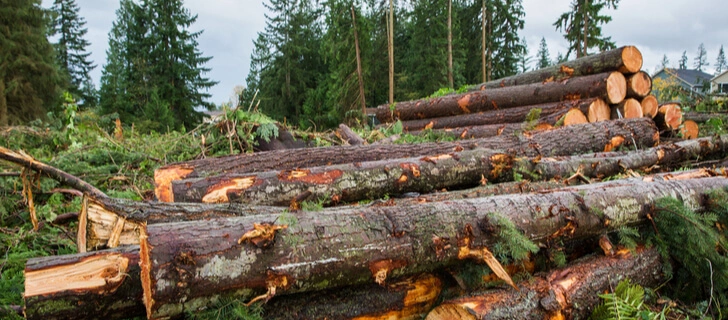
Selective Logging vs. Clear-Cutting
Clear-cutting is the removal of all or nearly all trees in the stand. In selective harvest logging, most trees remain.
What’s More Environmentally Friendly Selective Logging Or Clear-Cutting?
Some experts believe that selective cuts support forest regeneration because younger trees get more sunlight to grow, and pathogens get more sunlight to be destroyed. Regeneration after clear-cuts starts either naturally or by replanting in a couple of years. However, the next timber harvesting after clear-cuts will be possible on average after sixty years.
Why Is Selective Logging Better Than Clear-Cutting?
Clear-cutting allows logging many trees at once, which saves operation time, so it is good for time-management reasons. However, selective logging is still better than completely or mostly empty areas after clear-cuts because it leaves some wood to harvest for the nearest years.
Difference between Shelterwood, Seed-Tree, And Selective Cutting
As the name suggests, the seed-tree method leaves mature trees to produce seeds for new stand development. Seed trees are cut once the saplings properly establish. Shelterwood practice provides some shadow protection for the sun-intolerant species, and then mature trees are cut after 5 to 10 years. All these methods are selective in their nature, but the difference between them is the timber choice. Seed-tree and shelterwood practices promote forest revival, while selective cutting harvests the most expensive timber.
Selective Cutting Methods
Compared to clear-cutting, selective logging is a way more difficult to implement and its methods have a number of steps to complete:
- marking the trees;
- calculating the timber volumes;
- areas covered;
- equipment used;
- timber transportation options;
- protection of the remaining stand.
The last point implies herbicide applications and saplings’ competition with the older trees.
Considering the above-mentioned aspects, selective logging is performed either by cutting single trees or their groups.
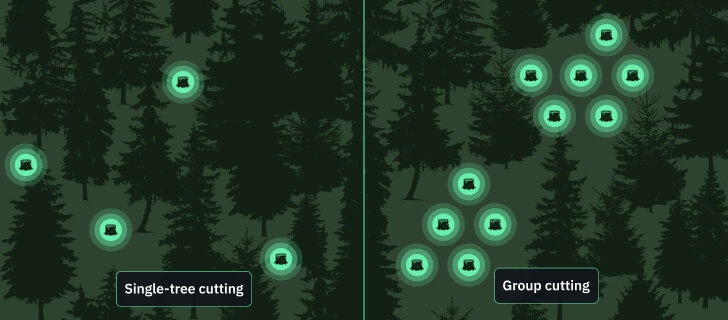
Selective Cutting Of Single Trees
According to this method, foresters remove the chosen trees individually. Such logging mimics the natural ecosystem process, when the trees die naturally, and ensures continuous harvesting. On the other hand, single-tree logging applies only to shade-tolerant species regeneration due to the limited sunlight penetration and ensures frequent harvesting thanks to the availability of mature valuable trees.
Group Selective Cutting
This logging type commonly cuts groups of older trees. It still ensures profitable timber production but makes wider gaps in the forest stand. It is similar to the ones occurring due to strong winds, floods and landslides, or tree diseases. However, the logging method is different from natural processes because it chooses only the most valuable timber (often of nearly the same age). Monitoring from the space, group cuts are easier to track in comparison to single-tree logging.
Combination Of Group And Single-Tree Selective Cutting
The logging methods are often combined, and economically valuable mature trees are felled either individually or in groups. All chosen trees that meet the required criteria are cut down along the entire perimeter of the forest area and transported with designated logging machinery.
It is a sustainable timber-harvesting method in forest management aiming to mitigate environmental negative impacts. It combines selective logging and directional tree felling as well as constructing trails and roads as narrow as possible, to cause the least disturbance and damage to nature.
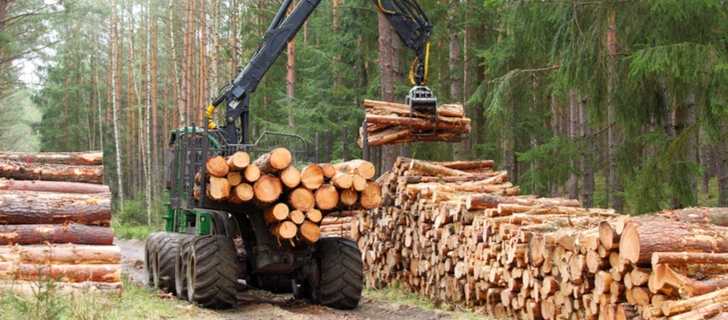
Advantages Of Selective Cutting
Even though the practice removes the strongest trees in the forest, there are certain benefits of such a practice. First, it leaves behind some important species. Second, forests are less subject to tree diseases. Third, this method promotes carbon sequestration, as proved by a study of Brazilian tropical forests by the University of California.
Among other benefits, selective logging also:
- Provides more light that kills fungi and is necessary for shade-intolerant species.
- Boosts seed growth in the cleared-up areas.
- Leaves some valuable trees for future logging.
- Prevents forest wildfires.
- Produces no smoke and air pollution issues compared to prescribed burning.
Like any other, this method of forest thinning doesn’t prevent wildfires literally but it reduces the amounts of fuels, which slows the fire spreading in the case of ignition. This is why selective forest cutting stabilizes the ecosystem and decreases fire risks.
Selective Cutting Negative Impact
This logging system has a number of negative consequences because all or most of the economically viable trees are cut in one season. Let’s consider the most essential ones.
Financial Impact
Even though the logging method chooses the most expensive trees providing the highest profit, this effect is only temporal. Mature tree cutting eventually spoils the timber quality and volumes, so forest owners should not expect a stable income over time. Selective logging doesn’t apply when it comes to forest sustainability, and this method cannot ensure continuous profit in the long run.
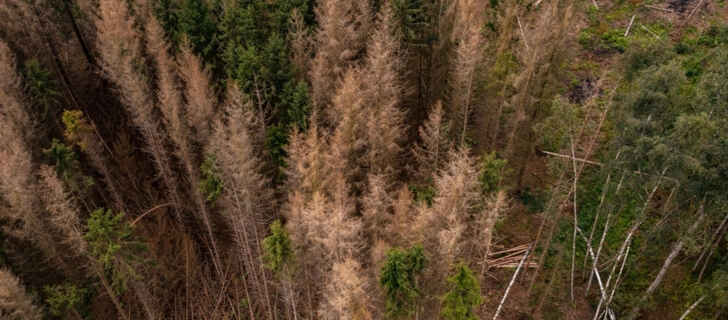
Future Management Options
High-grade logging provides the highest profit only during the first cut. However, removing the best timber will reduce the timber quality in the future. The second harvesting will be possible when valuable timber restores, yet the subsequent high-grade logging will be limited. Due to the poor economic value of the remaining trees, foresters have to refresh the stand to increase their profit. In this case, forest regeneration includes two options:
- cutting the whole stand and planting better species;
- letting the forest revive naturally until the trees are mature enough for harvesting.
Selective Logging And Deforestation
At first glance, selective logging is sparing because the stand is not felled completely but only thinned. However, there are certain drawbacks. First of all, felling can cover huge forest areas and remove thousands of cubic meters of productive forest. Secondly, selective cutting requires activities to collect and transport the harvested timber, which negatively affects the remaining trees. The movement of logging machinery disturbs the forest floor and topsoil, and transportation passages get wider with time, contributing to deforestation.
Environmental Effect Of Selective Cutting
By harvesting the best timber, selective logging promotes the growth of weeds and poor-quality trees like red maple, beech, and hemlock, negatively affecting biodiversity and reducing carbon sequestration. The method also impacts the stand symmetry and proportion as logging may cover larger areas in one forest part and smaller in the other.
Selective Timber Cutting For Wildlife
Logging the trees that produce a lot of masts negatively impacts wildlife because it decreases the availability of food sources. For example, red oak or black cherry provides food for deer, squirrels, bears, turkeys, and other birds, while the fruit of chestnut, beech, or oak is eaten by wild pigs. So when wildlife diversity matters, forest fauna should get favorable living conditions, suitable for each species. The density of the vegetation canopy is also important, so poor crowns won’t provide enough food for wildlife and its specific habitat.
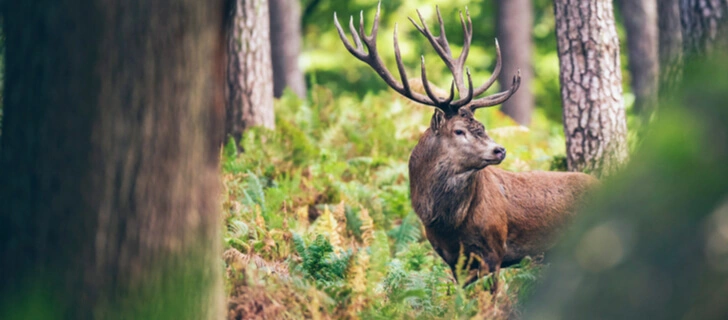
Satellite Technologies For Selective Cutting Implementation
Compared to clear-cutting, selective logging is much harder to monitor since it doesn’t involve the large-scale removal of forest cover.
EOSDA LandViewer offers powerful tools for near-real time satellite imagery analysis, enabling users to detect subtle changes in forested areas associated with selective logging. The platform also allows users to customize their analysis by choosing specific sensors, timeframes, and spectral bands, making it a valuable resource for monitoring various methods of selective logging and evaluating their long-term impact on forest health.
Deforestation Feature To Detect Forest Logging
Group cutting, common among the methods of selective logging, often leaves subtle traces in the forest, making it hard to detect with the naked eye. EOSDA LandViewer provides access to satellite images, including Sentinel-2 imagery data, and powerful tools to visualize and analyze these cut areas, even in dense vegetation.
For a detailed understanding of forest changes, EOSDA LandViewer offers tools like time series analysis, change detection, and customizable indices that help users track how specific areas evolve over time. This makes it easier to evaluate whether selective cutting activities have followed the original plan. For example, when a plot is marked for cutting, satellite imagery can be compared before and after operations to verify if the logged area matches expectations or if trees were removed outside of authorized zones — a reason to suspect illegal selective logging.
These capabilities are especially important in remote and ecologically sensitive regions where illegal activity can go unnoticed for long periods. A striking example is Chiribiquete National Natural Park in Colombia, where illegal activities initially went undetected before escalating into widespread deforestation.
What began as scattered trees cutting quietly evolved into widespread forest loss. Illegal logging in the park is often hidden beneath the dense canopy, but even in these thick jungle regions, satellite imagery ensures nothing goes unnoticed. With frequent satellite monitoring of forest stands, it’s now possible to detect suspicious logging patterns and verify whether any clearing is actually authorized.
Several factors have contributed to the ongoing deforestation in Chiribiquete:
- Unauthorized roads, including Tunia-Ajaju and Cachicamo-Tunia, have opened up remote areas of the park to deforestation.
- Agricultural expansion has driven forest clearing, with approximately 400 hectares converted to cattle pastures in 2019.
- The cultivation of coca and other illicit crops continues to push forest loss deeper into protected areas.
- Land grabbing by unauthorized occupants has led to severe fragmentation and degradation of the park’s ecosystems.
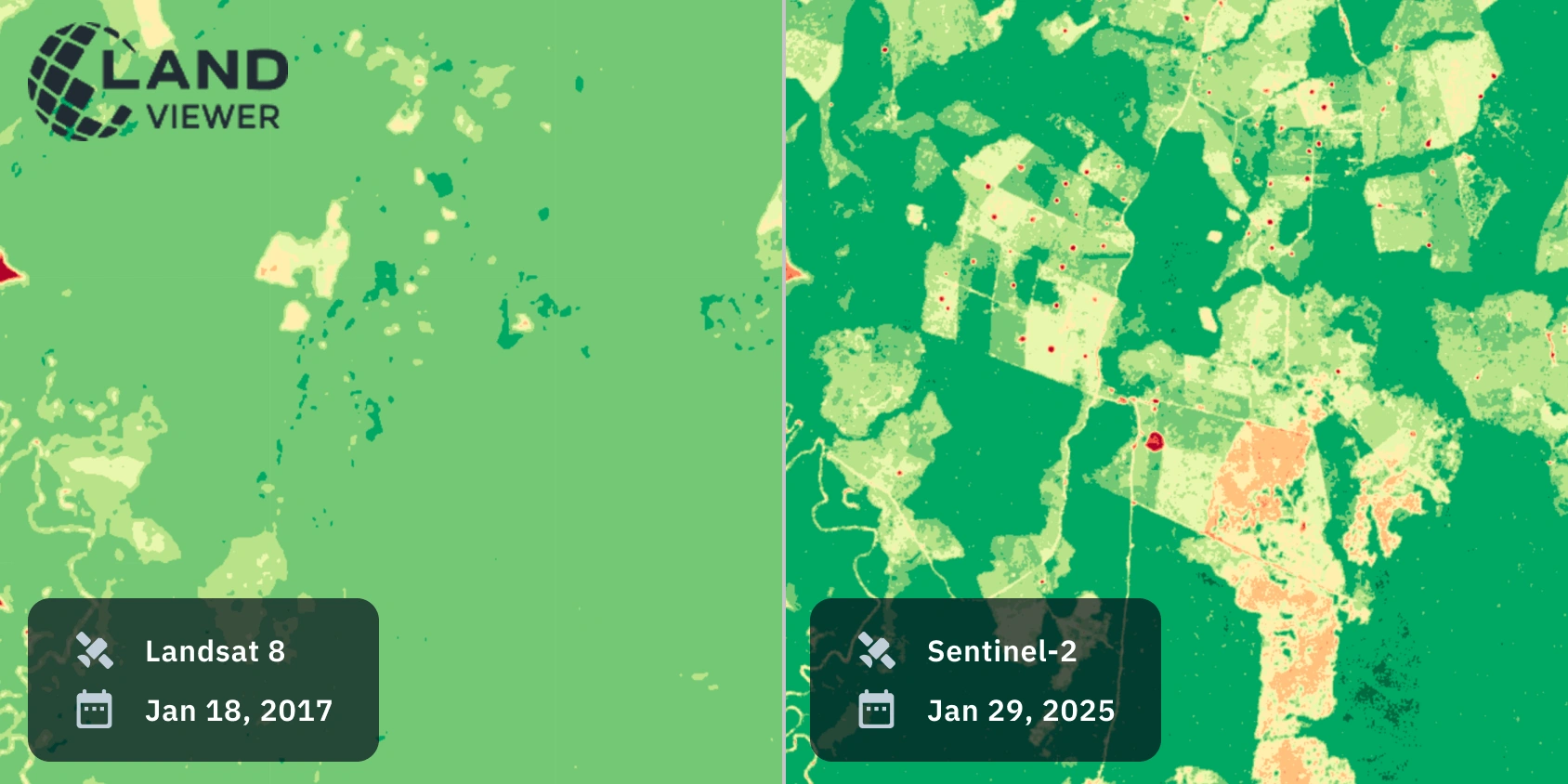
Forest Productivity To Detect Mature Trees
Selective cutting becomes smarter and more sustainable with EOSDA LandViewer’s powerful satellite monitoring tools. By using vegetation indices like NDVI, the platform users can identify the most productive forest zones where healthy, mature trees are concentrated — perfect spots for harvesting without causing lasting damage. These high-productivity areas not only offer more valuable timber but also recover better after cutting. EOSDA LandViewer’s analytical tools, like band combinations and clustering, make it easy to spot suitable trees even in less productive areas. With features like time series analysis and change detection, users can track changes over time and ensure tree cutting activities support sustainable forest management.
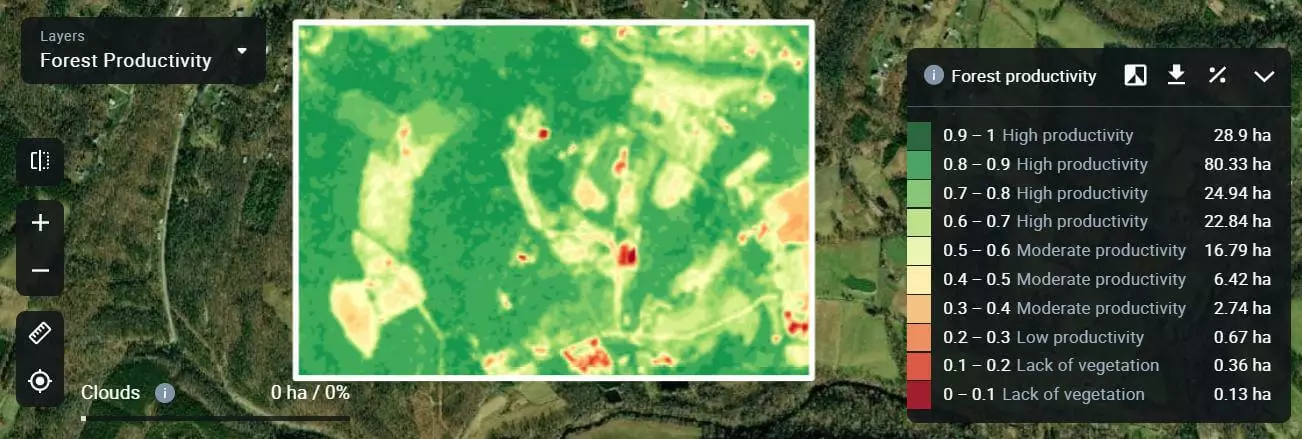
Forest Productivity To Track Vegetation Changes
Thinning can have lasting effects on forest productivity, and EOSDA LandViewer provides the tools to monitor these changes over time. By using time series analysis and comparing satellite imagery captured before and after thinning, users can observe shifts in vegetation health and detect subtle impacts that may not be immediately visible. More intensive thinning or damage from illegal selective logging can lead to gradual forest decline, making it essential to evaluate outcomes carefully. With EOSDA LandViewer’s ability to visualize and analyze changes across different dates, foresters can better judge whether a thinning method supports long-term sustainability or requires adjustment.
Contact our sales team and get an expert consultation for the rest of the EOSDA LandViewer features at sales@eosda.com.
About the author:
Kateryna Sergieieva has a Ph.D. in information technologies and 15 years of experience in remote sensing. She is a Senior Scientist at EOSDA responsible for developing technologies for satellite monitoring and surface feature change detection. Kateryna is an author of over 60 scientific publications.
Recent articles

Analyze 2025 & Plan Your Best Year Yet: LandViewer Christmas Offer
It’s the most wonderful time of the year! The Christmas holidays are here, and so is your chance to analyze 2025 and plan a prosperous 2026 with more affordable Pro plans in LandViewer.

EOSDA Models Climate Change Impact On Sugarcane Yields
EOSDA modeled future temperature, rainfall, and other climate impacts on Veracruz sugarcane. The results help growers plan long-term adaptation strategies, including timing, varieties, and irrigation.

EOSDA LandViewer Black Friday Sale: Exclusive Offers & Giveaway
This Black Friday, LandViewer offers new users the chance to save on monthly plans, get extra months with yearly subscriptions, and participate in a free annual plan giveaway.

